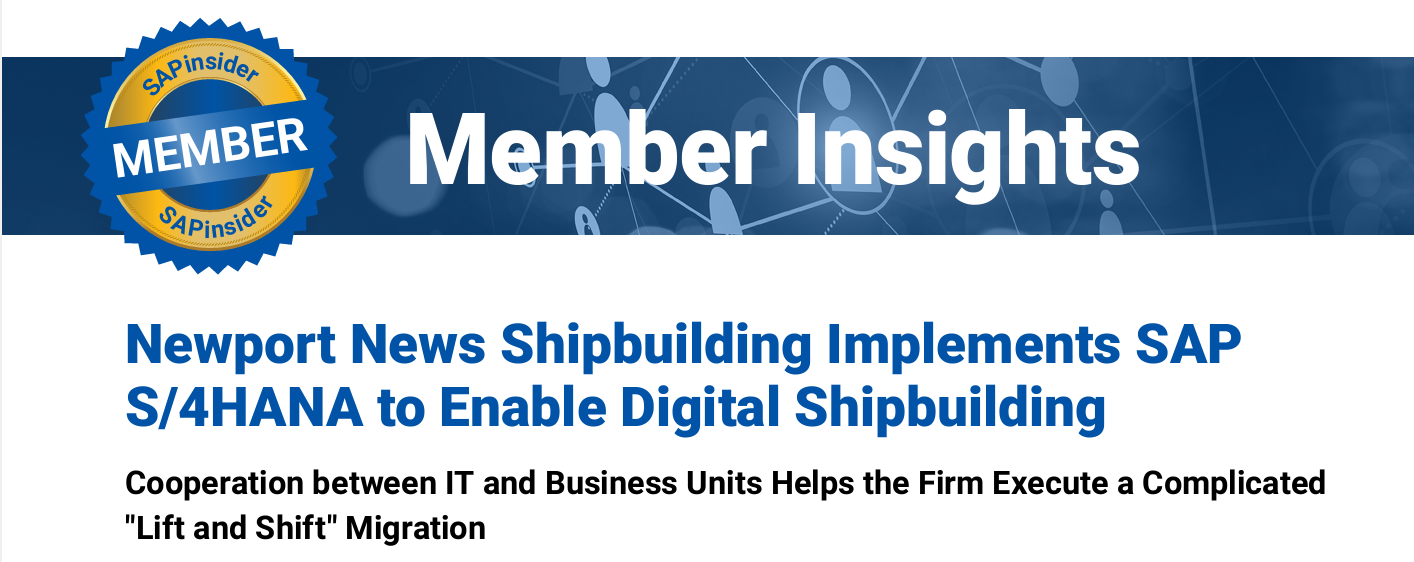Digital Transformation, Cloud Computing Driving SAP S/4HANA Development
By Fred Donovan, Senior Editor, SAPinsider
In developing SAP S/4HANA, SAP responded to several market drivers, including digital transformation, cloud computing, and changes in the rules of business success, said Mary Sibley, head of the North American Center of Excellence for SAP S/4HANA at SAP, during her Dec. 1 keynote at SAPinsider’s Finance and SAP S/4HANA virtual conference.
First, organizations are embracing digital transformation to make them more productive and agile. “There is a great interest in digital transformation. It is reshaping all of the business processes,” Sibley said. COVID-19 has accelerated the interest in digital transformation because the pandemic has exposed the areas in organizations where updating is needed, she judged.
Second, more organizations are moving to cloud computing to benefit from innovation, improve productivity, increase flexibility, reduce costs and downtime, and stay ahead of the next technology wave.
“Cloud offers organizations the opportunity to shift expenses away from maintaining systems and focusing on innovation and responding to the changing business environment,” Sibley said.
Third, the “rules of business success are changing,” she noted. Companies want the flexibility to respond to volatile markets and supply chain disruptions. Younger employees are mobile savvy and want to contribute to society, and customers are demanding unique and personalized experiences. And organizations want to be more responsible and promote sustainability.
SAP S/4HANA and Market Drivers
To address these drivers, SAP developed SAP S/4HANA to provide an improved user experience with real-time analytics, embedded intelligence, and other new functionality.
SAP set out to simplify its flagship ERP platform. By leveraging the SAP HANA database, SAP S/4HANA is “simpler and more effective for users to get at the underlying data to make good decisions in today’s rapidly changing world,” Sibley noted.
In addition, SAP developed an app-like approach for SAP S/4HANA to improve the user experience, especially for younger workers. The interface is consistent across devices and platforms, and embedded analytics helps improve decision making, empower employees, and quickly onboard new employees, she said.
SAP also embraced new technologies with the SAP S/4HANA platform, including bots, machine learning, and artificial intelligence.
These technologies enable organizations to deploy an intelligent ERP system to allow them to anticipate issues, shift work from people to machines, and optimize processes through automation and machine learning.
Two examples of new functionality are SAP Billing and Revenue Innovation Management (SAP BRIM) and the universal journal. The SAP BRIM feature provides flexible billing options. “In today’s world, we are seeing more interest in multiple types of billing, such as products as a service. It’s important to provide your customers a single invoice – that is the SAP BRIM capability,” she explained. The universal journal provides the attribution of journal entries in a single table so that “profitability analysis is available in multiple dimensions,” she said.
Sibley explained that SAP S/4HANA adoption is on the rise across industries. There has been a spike in go-lives – from 3,000 in May 2019 to more than 10,100 in October 2021.
According to Sibley, SAP customers that have deployed SAP S/4HANA report:
- 10%-20% increase in revenue from new offerings
- 10%-20% increase in customer satisfaction
- 75% lower total cost of ownership
- 50% reduction in data footprint
- 10%-40% increase in productivity
- 10%-30% increase on-time delivery rates
- 60%-70% reduction in total vendor invoice processing time
- 10%-15% reduction in total logistics costs
- Up to 10% reduction in total manufacturing costs
- 40%-50% reduction in time spent on period-end close
- 25%-30% reduction in risk and compliance costs
“Organizations that take the time to identify the big three to five reasons why they are moving to SAP S/4HANA and hold those up as their North Star for change have excellent outcomes,” she observed.
Slowdown in SAP S/4HANA Implementation
In introducing Sibley, Robert Holland, SAPinsider’s Vice President and Research Director, detailed some recent SAPinsider research on SAP S/4HANA.
In interviews with SAPinsider community members, Holland found a slowdown by organizations implementing SAP S/4HANA. Some of the factors contributing to the slowdown include the COVID-19 pandemic, which prompted some organizations to put major projects on hold, and the extension of existing maintenance.
“For executives, SAP S/4HANA still remains a key topic, and they are planning for it, even if they are not doing anything with it right now,” Holland related.
There was a 50% jump in the number of organizations considering a selective data transition for their SAP S/4HANA deployment model, according to SAPinsider’s Deployment Approaches for SAP S/4HANA Benchmark Report.
“Among larger organizations with more complex ERP implementations, selective data transition has become a more popular option for moving to SAP S/4HANA. It gives you the ability to bring over your structure and then choose what data you bring with you,” he said.
According to SAPinsider’s recent Enterprise Cloud Deployment 2021 Benchmark Report, 99% of the 187 SAPinsider community members are running some enterprise systems in the cloud, and 88% are running at least some SAP workloads in the cloud.
More than half of members are running SAP S/4HANA in the cloud, either in a private or private/hybrid cloud environment or a public or public/hybrid cloud environment.
In addition, nearly three-quarters of respondents said they plan to move their on-premise enterprise ERP systems to the cloud within the next two years. However, respondents running their SAP S/4HANA system on-premise are less likely to move it to the cloud soon because they have just invested in on-premise infrastructure, Holland observed.
What Does This Mean for SAPinsiders?
Clearly define the three to five reasons why you are moving to SAP S/4HANA. Once you have a clear idea of why you are moving to SAP S/4HANA, use those reasons as a focal point for your staff in your implementation journey. “Organizations that take the time to identify the big three to five reasons why they are moving to SAP S/4HANA and hold them those up as their North Star for change have excellent outcomes,” Sibley says.
Carefully evaluate the financial and infrastructure potential that the move to SAP S/4HANA can help you achieve. The move to SAP S/4HANA requires significant time, resources, and financing to succeed. Build your business case based on the long-term potential of SAP S/4HANA, not just as a way to reduce that cost of legacy systems and infrastructure and improve efficiency and scalability. Focus on the long-term return on investment from the move to SAP S/4HANA.
Understand how the “rules of business success are changing” and stay ahead of these changes. Customers are demanding unique and personalized experiences, and younger employees are mobile savvy and want to contribute to society. Consider how moving to SAP S/4HANA will help you address the evolving needs of customers and employees.








